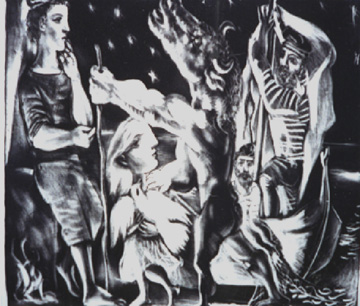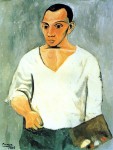
Pablo Picasso
Spanish, 1881-1973
Blind Minotaur Guided by a Little Girl in the Night (Minotaure aveugle guide par une fillette dans la nuit), 1934
aquatint
13 1/2 x 17 1/2 in.
SBMA, Gift of Wright S. Ludington
1958.27

Self portrait
RESEARCH PAPER
The work is a drypoint etching by Picasso using a conventional resin-based aquatint and an unusual added treatment, heavy melted sugar solution, that Picasso 'painted' on the copper, let dry, then re-etched to give the delicate shading seen, for instance, on the small boy's clothing above. The printer, Roger Lacouriare, showed Picasso this sugar (or 'lift-ground') technique in 1934. Sheets No.s 24, 26, 27, and 97 of the Suite Vollard were made with this technique. Bolliger (Xiii) calls them 'true masterpieces'.
The Ludington gift was treated at the Balboa Art Conservation Center, San Diego, CA in September of 1958. Staining and masking tape residue were removed with organic solvents. (See SBMA files on SBMA 58.27 for letter re this.)
Ambrose Vollard, son of a notary, was born on Reunion Island in 1867. Scorning law as a career, he became a dealer in fine arts, purchasing paintings from Degas, Forain, Renoir, Bonnard, Roussel, Vuillard, Denis, and most importantly, Cezanne, whose first exhibition of over 100 paintings was organized by Vollard. After 1900 Vollard's interest switched to graphics, and he bought from Bonnard, Toulouse-Lautrec, Munch and Redon. His next step was publishing and he spared neither time nor money on works by Derain, Dufy, and others - most importantly, young Pablo Picasso. These works by Picasso, among Vollard's greatest contributions, included the Saltimbanques' series of 1904 (which included SBMA's "The Frugal Repast" (1941.2.28)), Buffon illustrations for Histoire Naturelle , 21 woodcuts for the Helene chez Archimede by Picasso's great friend Andre Suarez, and finally the 100 sheets of a Suite dedicated to Vollard and created between 1930 and 1937 ... the latter year seeing the completion of the three etchings of Ambrose Vollard, a fitting climax to the Suite. (c.f. SBMA's "Portrait of Ambrose Vollard IV (SBMA 1984.2) which Bolliger calls Sheet 99 and names 'Vollard II'.)
After Vollard's death by automobile accident in July, 1939, the greater part of Suite Vollard was purchased from his estate by a dealer in prints, Georges Petiet, and the first edition printed on paper watermarked 'Vollard' and signed 'Picasso' were offered to the public by Picasso's dealer, Kahnweiler, in 1950. Each edition consisted of 250 sheets. According to most accepted classifications, the Suite has 27 plates dealing with assorted subject matter and 73 plates on five themes: 'The Sculptor's Studio', 'The Battle of Love', 'Picasso as Rembrandt', the 'Minotaur,, and finally, the 'Blinded Minotaur'. All the etchings were made between 1930 and 1934 (save the three Vollard portraits); however, most were made in seeming leaps of creativity: eleven Minotaur plates were completed in one short month in 1933; the Battle of, Love likewise in '33; the Rembrandt series in January of '34; and, the Blind Minotaur plates in September and October of 1934. It should be noted that the numbering of the editions is quite arbitrary and does not follow the actual historical etching of the plates. For instance the sugar-tint etchings priorly mentioned (24,26,27 and 97) were (except for the Vollard portraits) the last to be completed, probably in November of 1934.
The Suite tends toward the neo-classical: not surprising since Picasso's travels to Naples, Florence and Rome influenced much of his work. Wealthy beyond his dreams, unaffected by the worldwide economic depression of the '30's, Picasso purchased a chateau at Juan-les Pines on the Riviera in order to devote himself to sculptry, and the Suite was heavily influenced by that decision. Picasso himself appears in a number of guises throughout the Suite: an intent young boy stares at his models; a youthful bearded adult sculptor works amid his nude models (rather frolicsome scenes). Suddenly the bearded man becomes a saytr, then a minotaur - half man, half bull-beast. A second stock character in the Suite was his latest mistress, Marie Walter Theresa. A third was Olga, his wife, who had recently given birth to their son, Paul. (Marie-Theresa was pregnant in 1934 with Picasso's soon to be born daughter, Maya.)
The mysterious minotaur is a companionable beast: he lies on a couch drinking champagne with a wreathed classical beauty. At times he carouses with the scultor amid the naked curves of two women ... somewhat the worse for drink. But in the Battle of Love everything changes, and a wild sexual scene ensues. (Huffington said Picasso never made love, he only raped.)
The minotaur was not of Picasso's invention but rather the name of a magazine (Minotaure) largely devoted to Surrealism. The first number was illustrated by Picasso, contained Brassai's photographs, and Picasso himself provided the cover: one of his etchings of the minotaur adorned with ribbon, lace, and flowers from one of Olga's discarded hats; But Picasso's alter ego Minotaur, by Sheet 92, sits in the bull ring audience, bemused but happy, sandwiched in between Marie-Theresa cum-little-girl and Olga his wife. And in Sheet 88, the Minotaur is in the bull ring, exhausted from his 'labors'. A young man (Picasso-the-littleboy) wounds the old minotaur with a savage stroke of his knife while little girl Marie-Theresa looks on in admiration. But the figure of Olga, his wife, holds the minotaur dawn while young Picasso stabs ... what? Himself, apparently.
The Blinded Minotaur series consists of four sheets (No.'s 94 through 97) and the first three are a kind of 'working out' for Sheet 97. This etching (SBMA 58.27) Bolliger (op.cit.) calls "...a work magnificent for its mood, its composition, its symbolic force, and its technical perfection. The fascination of this work," continues Bolliger, "is enhanced by the mysterious lights that seem to emanate from the bodies themselves."
Indeed so. This scene (Sheet 97) takes place on a star-filled night, almost, perhaps, a night fit for a Nativity. A young girl (Marie-Theresa, readily identifiable from her Roman-nose profile) holds a fluttering dove-of-peace as she helps the wounded, anguished minotaur. The scene divides into three compositional parts using the minotaur's staff and the fisherman's oar as vertical elements. Thus one-third is occupied by the bemused boy-Picasso, the middle-third by the girl-with-fluttering-dove helping the minotaur, and the right-hand third by two mysterious fisherman who might be Wisemen or Shepherds of the Nativity but are apparently only compositional devices. The minotaur's outstretched arm is a 90 degree angle from the fisherman's oar and the minotaur's hand points directly at the hand of boy-Picasso.
But the central element that rivets our attention must be the anguished face of the wounded minotaur! We are to see this face again, within a year, on the savagely wounded horse in Guernica. Picasso's image of the horrors heaped on the small Spanish village of Guernica by fascist bombing planes. The gray-black tones, the terrified screaming animals, Guernica is a logical outcome of Sheet 97 of the Suite Vollard. But in this compelling and masterful end to the Suite, we also see the climax of three years' work. He (Picasso) watches stoically as the girl (his pregnant mistress) leads the blinded beast (also Picasso) toward redemption and peace. Little-boy Picasso (now back in his pre-pubescent childhood) has taken up his former detached coolness that absolves him of any responsibility while he contemplates the end of the movie.
Bibliography
Daix, Pierre, Picasso, Life and Art; (translated by Olivia Emmit); Icon Editions. New York, NY. 1987
Elgard, Frank & Maitland, Robert; Picasso (translated by Francis Scarfe); Frederick J. Praeger, Pblr. New York, NY. 1956.
Huffington, Adrianne Stassinpoulos; Picasso - Creator and Destroyer; Simon and Schuster, Pblr.; New York, NY. 1968.
Bolliger, Hans (Introduction to) Picasso's Vollard Suite;Thames & Hudson, Pblr. London, England. 1956. (New York Edition, 1985.)
Prepared for the Docent Council, SBMA, by George F. Christians, March 12th, 1995.
SBMA CURATORIAL LABELS
This is one print from a series of 100 that make up the Vollard Suite, which were commissioned by the Parisian dealer Ambroise Vollard in the 1930s. The plates were made between 1930 and 1937, but the prints were not issued to the public until the 1950s. None of these prints have a specific literary reference, but they do contain allusions to Greek mythology. The minotaur was a creature with the body of a man and the head of bull who was imprisoned in a labyrinth built by the architect Daedalus and who required in some versions of the myth a regular sacrifice of children to appease him. In this print, Picasso has shown the minotaur as powerful and potentially dangerous, but also blind and tame as he is led by a small girl. Nonetheless, there is a feeling of danger in this print with the fire casting strange shadows and characters hovering around and staring, as if waiting for something to happen.
- Serenity and Revolution, 2024
